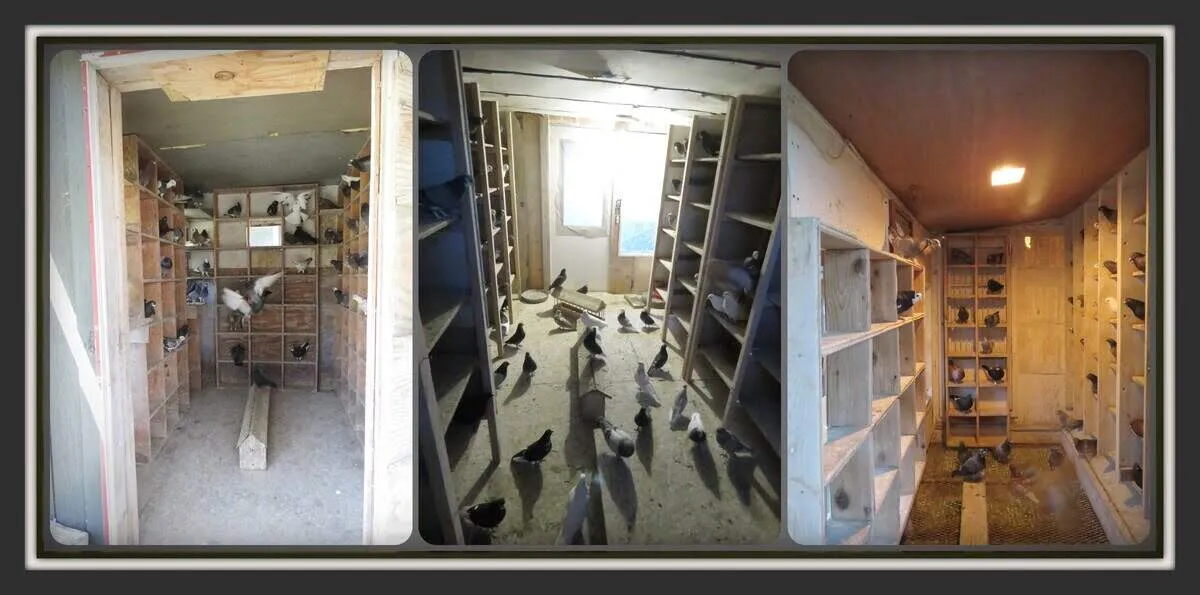The assumption that a single Loft/Coop/Fly-Box setup is suitable for all weather conditions without requiring modifications is incredibly naïve. I know that statement may sound a bit harsh, but think about it for a moment. Do you heat your home in the winter and cool it with air conditioning or fans in the summer? Do you protect yourself from extreme weather? Well then, what makes you think animals don’t require the same weather protection as humans? Do animals die from overheating? Do animals die from bug infestations and viruses? Do animals freeze to death? Do animals die from frostbite…They absolutely can and do at times. In this article, I will explain how we set up and modify our lofts in response to shifting weather conditions, which has allowed us to successfully raise healthy pigeons with remarkable lifespans.
A Weather Perspective:
Let me share a few personal tales to highlight the importance of loft/coop/fly-box weather modification. First example: On those icy, wintry days, when we take our dogs for lengthy walks and runs to relieve their pent-up energy, occasionally their paws start to bleed in the snow. (I’ve tried dog boots; however, our dogs will tear them off at the first opportunity, so they’re pretty much worthless.) The alternative is to watch them body-slam each other as they leap from the couch onto their dog beds on the floor. Cabin fever does, indeed, bring forth their creative side. It’s like watching all-star wrestling.
Second example: Several years ago, we fought tooth and nail to buy a dog from a terrible dog owner. This dog was only two years old and had been living outside in a kennel year-round. When we brought him to the vet, he was skin and bones, had leg abnormalities as his legs bowed outward from leaping up on the kennel fencing, had little exercise, and was riddled with intestinal parasites. The most distressing part was when the Vet informed me that he had been exposed to the cold for so long that his tail had frozen off, making it considerably shorter than normal for a Labrador.
Heating / Cooling / Ventilating
Consider your pigeons: do they have a metal grate or wire floor, open doorways, windows, portholes, or walls where cold air and bitter cold winds can enter? Are you aware that a pigeon’s feet can become so cold that frostbite causes them to lose their toes? Did you know that when a pigeon’s body heat is no longer sufficient to keep them warm, they will sit and shiver in the dark all night, resulting in low immunity, disease, death, or an overall shortened life span? Yes, wild pigeons do live outside year round, but their live expectancy is only a few years at best. Don’t get me wrong: the heat can be just as harmful, as we’ll discuss in this article.
Ventilation… Too Much or Not Enough…
Is it possible to have too much ventilation? How about inadequate ventilation? Yes, this is true whether you have a small fly-box, a medium-sized coop, or a large loft. In the hot, muggy summer months, birds need a lot of moving air to be cool; in the cold, windy winter months, they don’t. In the cold, they require warmth. For this reason, maintaining a daily cleaning regimen for the pigeon house structure is essential. The air in your pigeon house structures should be kept clean enough that you are able to pull up a chair inside and sit with your birds or read a book…lol without have any breathing issues of any kind. A clean loft pulse clean air equals healthy birds. This means your birds stay warm in the winter with only a small amount of ventilation coming in.
Summer Months
- Insulate the entire pigeon house structure – including, walls, roof, doors, windows, floor – this keeps the moisture out, stays cooler and less likely to have any kind of bug or rodent infestation if you are keeping it clean.
- Utilizing insulated windows with screens is advised. Use screens to cover all openings including portholes to keep mosquitoes and flies out. We put wire over the screen inside to protect screen from birds hanging on it and ripping screens.
- If you have open wire or grate floors – cover outside of pigeon structure with plywood or smartboard siding as a wrap/skirting year round to prevent any mosquitoes and rodents from getting in through the open floor. The outside wrap/skirting is easily attached and removed with screws for cleaning out underneath the loft/coop/fly-box.
- Use fans inside pigeon structures during summer heat to keep pigeons cool from heat/humidity.
Winter Months
- Insulate the entire pigeon house structure – including, walls, roof, doors, windows, floor – this keeps the moisture out, stays warmer keeping out the cold winds and less likely to have any kind of bug or rodent infestation if you are keeping it clean.
- Using insulated windows, slightly open about an inch or two, on those cold brisk, windy day/nights. Otherwise use glass window pane, Plexiglass, or wood board to cover any openings at night.
- If you have open wire or grate floors – cover outside of pigeon structure with plywood or smartboard siding as a wrap/skirting. Then lay plywood over the grate/wire floor and spread straw over the plywood for the winter to keep birds warm. Straw is easily picked up and replaced for cleaning.
- Use heat lamps inside pigeon structures during cold winter. Break up the long, cold 15 hour nights of darkness with lights.
We are quite admit about our pigeon’s health and with that means protecting them from mosquitoes, nates, biting flies, etc. Just before dusk, the mosquitoes venture out from the woods. To protect our birds, we lock them all inside their lofts beforehand covering every opening with screen. If a screen gets a hole, we will repair that hole ensuring mosquitoes have no access points to enter inside the loft.
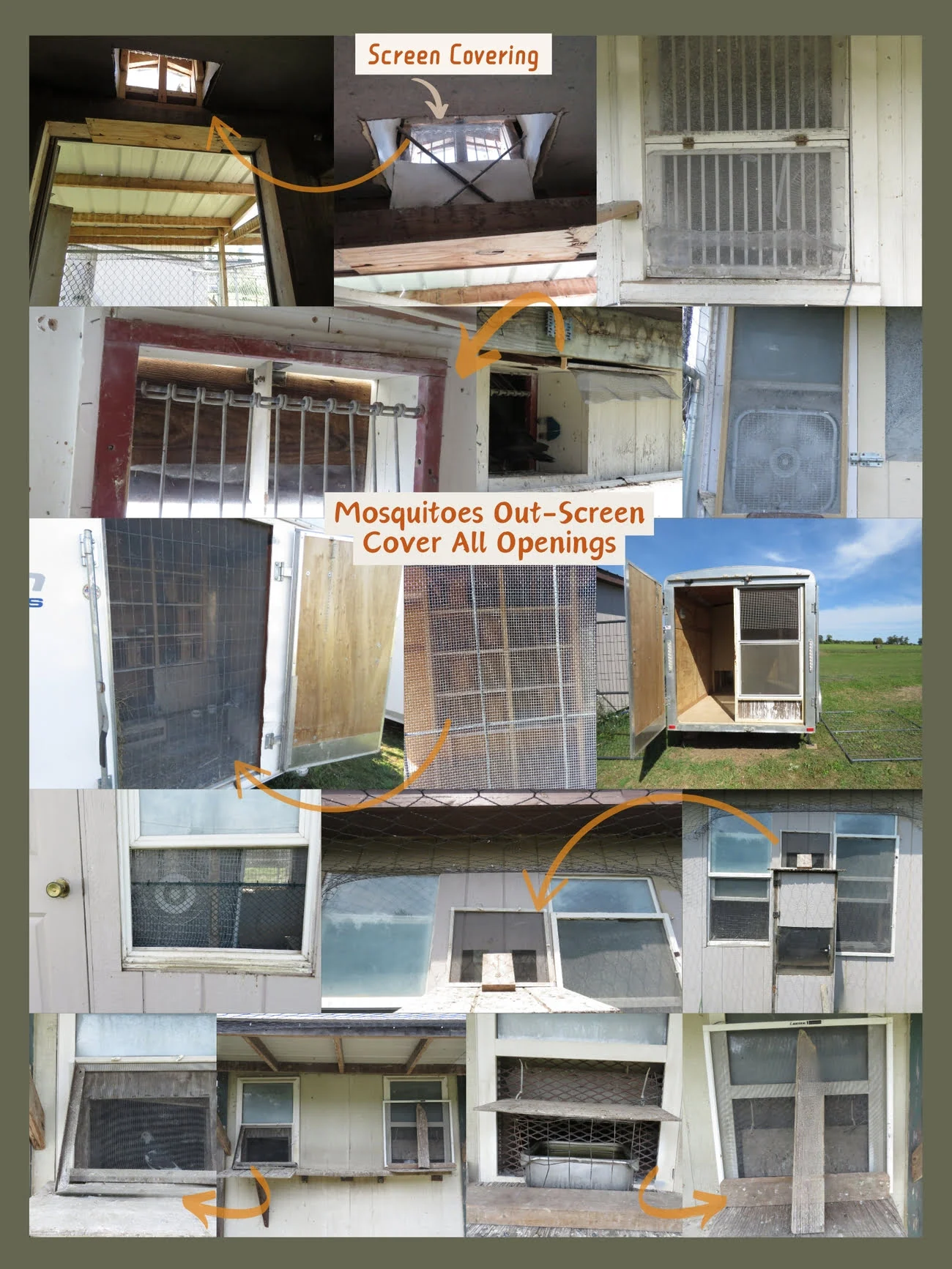
Our birds don’t mind getting locked in as we have lights inside for them to move about and enjoy the fans blowing. Just before I leave my lofts, I flip each light switch off, leaving the fans on. This prevents the draw of mass mosquitoes outside the screens to the light. This system works well for us.
Please know, you will have to keep the screens clean as they will accumulate dust, debris, I spray them down with the hose or brush off with a soft bristle hand broom when they need it. This too will ensure the fans are able to continue to suck fresh air inside.
We cover any exposed screen inside the lofts with small hole wire to prevent birds from hanging onto the screen causing holes or punctures.
Summer Set-Up: Box Fans to Cool Birds
Although summer is pleasant, it also brings heat, humidity, and, at times, sticky, stagnant air. Oh wait, let’s not forget your garden variety of biting flies and the awful biting mosquitoes. Most people use air conditioning in their automobiles and houses to stay cool. But hey, what do you know? Animals, like people experience heat and are at risk of overheating. Buying fans for your birds’ fly boxes, coops, and lofts is an easy fix. The feathers of your bird won’t tangle in the blades, so don’t worry.
In the smaller lofts, I use 12″ box fans, and in the larger ones, I use 20″ box fans. When the temperature rises to roughly 70 degrees Fahrenheit and above, I leave them on all day. If there’s little to no breeze, I will start using them even sooner. When it’s hot, humid, and little to no breeze, I’ll leave them on all night. But on nights when it actually cools down to a reasonable temperature and there is a lovely breeze, I will turn them off (depending on temp) anywhere from 8pm to around midnight and turn them back on around 7-8 a.m. Just because the temp feels nice outside doesn’t always mean it’s nice inside lofts. I enter each loft periodically throughout the day to see how it feels inside to determine what the birds need.
I’ve been doing this for a long time. My birds really enjoy it; they’ll go out to fly and then return to the loft to cool down and chill in front of the fan on hot days. It’s very relaxing for them. During the summer, I keep all of the fans on high, but occasionally, in the evenings and at night, depending on the humidity and temperature, I may turn them down to medium or even low.
Here we display our various lofts, each provided with a fan inside for the pigeons. On hot humid days, it’s fairly common to find all our birds inside their lofts just hanging out chilling in the cool breeze.
Like with anything, you will need to clean/pull/remove any loose feathers that may get caught in the front and back of the fan. We make a daily habit of checking each fan daily. This ensures our fans continue to work without fail.
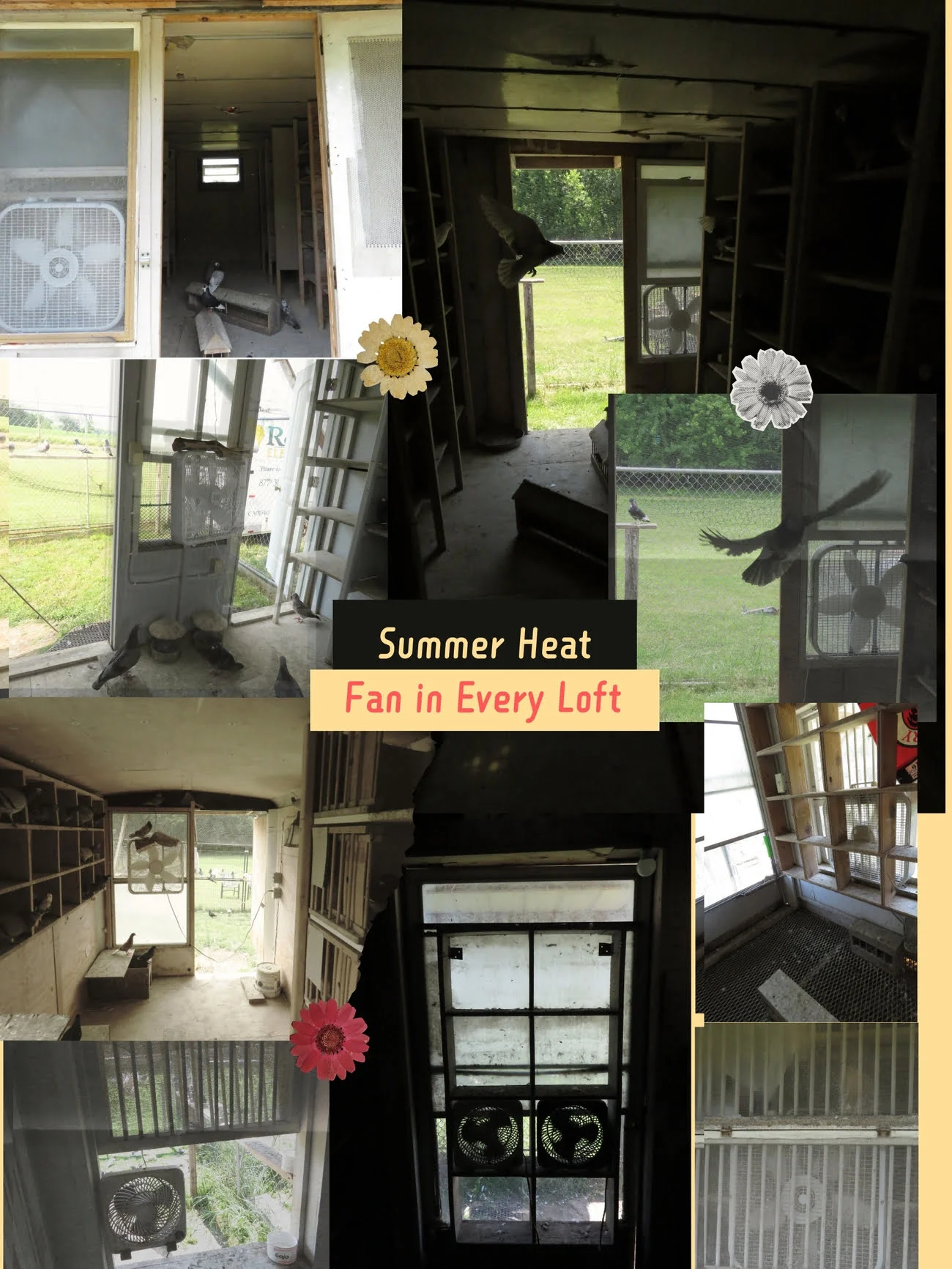
When summer ends, upon removing each fan, we use the compressor hose and blow out each fan keeping them really clean before putting them away for the winter.
Winter Set-Up: Heat Lamps to Warm Birds
Nothing is more distressing than learning that someone’s birds have died due to cold temperatures. That should never happen, yet we’ve had individuals approach us about buying birds from since their birds died from freezing to death. These folks didn’t think much of it; it happens, they would say. To be honest, that’s just terrible, disgusting negligence. As you might expect, we sent each of them packing, birdless.
First and foremost, any pigeon structure—loft, coop, or fly-box—should be completely insulated to safeguard birds against hypothermia. Purchase a heat lamp or two. Seal off any openings/gaps to keep wind and cold from entering. If the floor is wire-grate floor, lay down the identical-sized plywood so that it covers the entire surface, then spread straw over plywood. This will keep cold from coming in and will keep pigeons’ feet warm. Make certain that all four walls are completely enclosed with wood ensuring no open, exposed, or wire cage-style walls. Cover all open portholes at night as well as during the day if it’s too cold to go outside. Since we ran Romex electric to my lofts (we used extension cords prior), we leave the heat lamps on all day and all night when the temps dip down below zero.
We ran Romex electric to my lofts (we used extension cords prior). When the temps dip down below zero, we will leave the heat lamps on all day and all night. If it’s not to cold, I’ll turn them off around 9p.m.-11 p.m. Doing this not only ensures they’re staying warm but it also affords them freedom to move about. They’re not forced to sit in one spot, cold, shivering in the dark. Let’s face it, winter nights are long with roughly 15 hours of darkness starting around 4:30 p.m. Because I do this, my birds are quite active and healthy over the winters.
For any opening in our lofts without an actual storm window, we cover with Plexiglas, or extra glass windows over the outside of openings. The portholes are then covered with removable thick fabric type insulation. We then add heat lamps to extend light to break up the long dark nights as well as additional warmth.
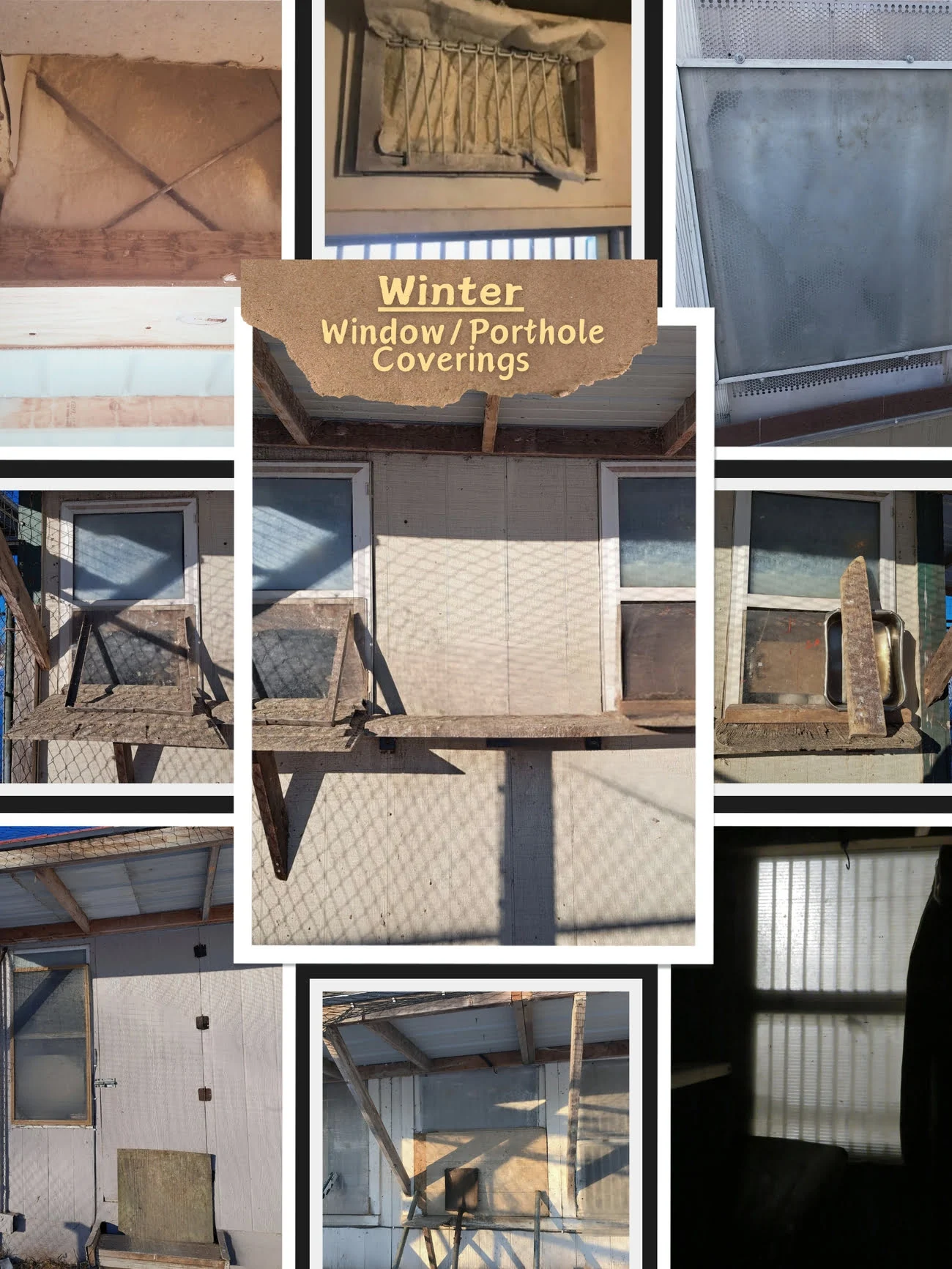
For any opening in our lofts without an actual storm window, we cover with Plexiglas, or extra glass windows over the outside of openings. The portholes are then covered with removable thick fabric type insulation.
We then add heat lamps to extend light to break up the long dark nights as well as additional warmth. Any rubber open grate floor is covered with skirting boards around the outside and plywood and straw cover the inside floor.
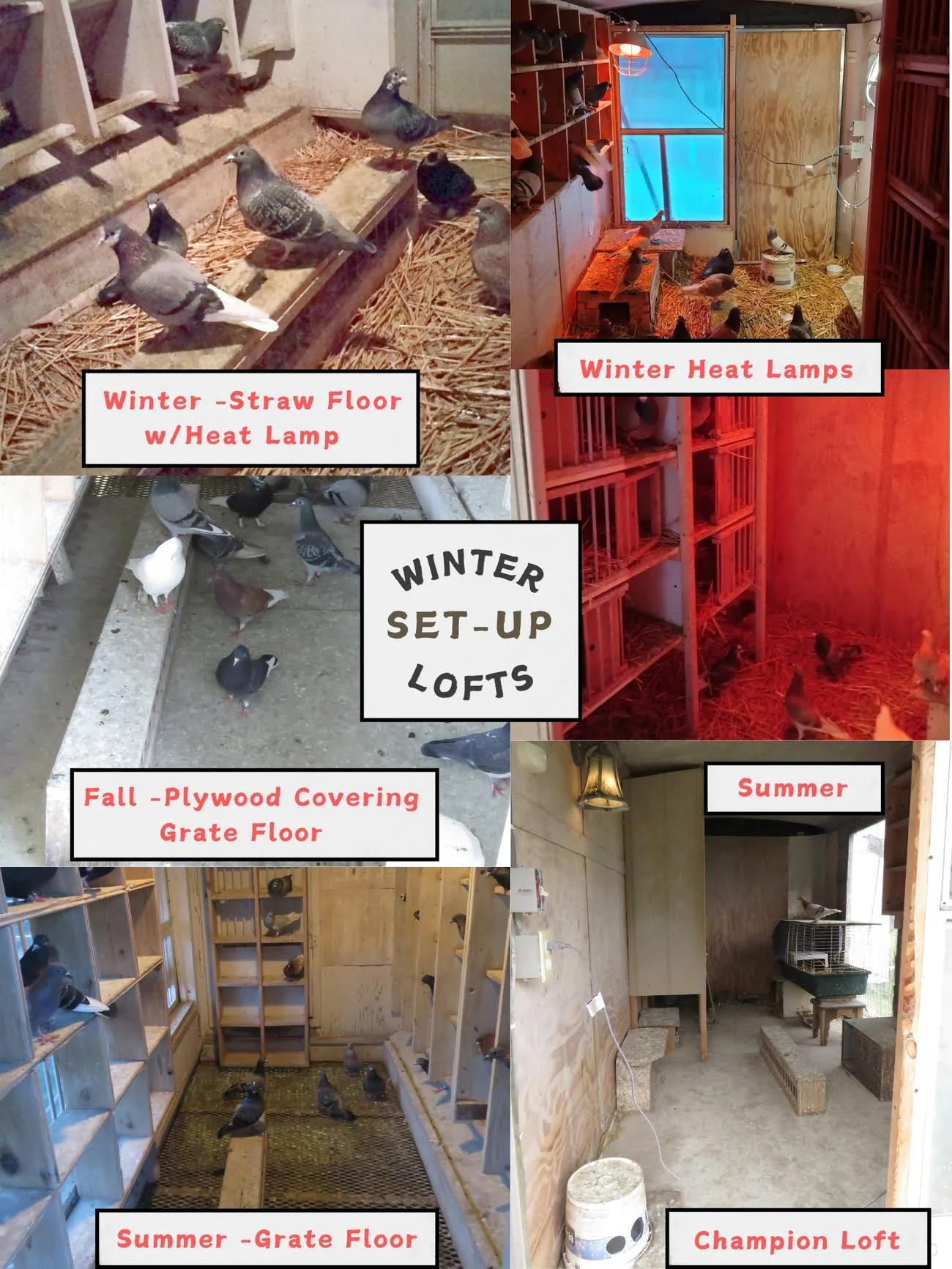
In Conclusion:
So now that you know how we operate our lofts, we hope we were able to offer you some new ideas to try with yours. As we stated above, we do our best to ensure the health and safety of all our birds. We are open to answer any questions you might have regarding our set up. Weatherizing your lofts is just as important as the food you feed and the cleanliness of your lofts. So, really hoping we were able to offer some new info.
So what have you learned… Screens protect against mosquitoes and other flying biting bugs; fans cool birds in lofts; covering openings in winter prevents cold air from blowing in and heat lamps not only warm birds, but also breaks up the excessive long dark winter nights. That’s all for now; drop us a line if you have any questions.

